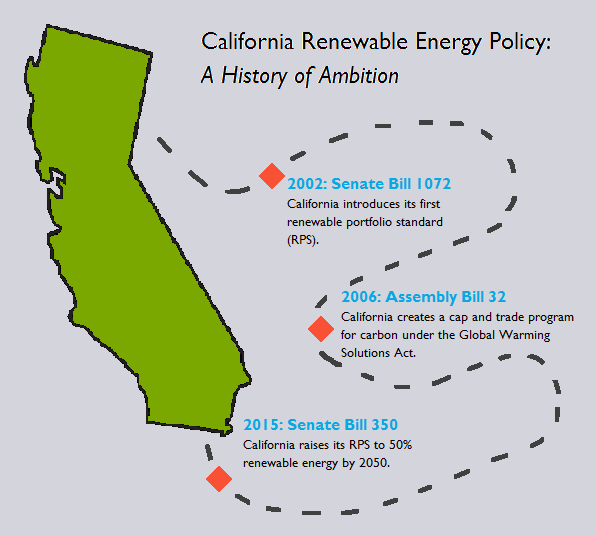What Hath California Wrought?
Legal Planet: Environmental Law and Policy 2019-09-12

California’s climate policy have been a success, but quantifying the effects is complicated. It’s harder than it might seem to determine whether a climate regulation has succeeded. California has clearly hit or exceeded its target for overall carbon emissions reductions under its method of carbon accounting. But if we ask how much global emissions are lower now (or will be lower in the future) because of California, that metric is harder to assess.
It does seem pretty clear that emissions within the state’s borders are lower than they would have been if you held everything constant except California climate policy. Total emissions from California power generators were pushed up due to the use of natural gas to replace nuclear power from unsafe plants, but then pushed back by elimination of coal and expansion in the use of renewables. Car emissions within California are lower than they would otherwise have been due to restrictions on greenhouse gas emissions, which California adopted on its own and then harmonized with federal restrictions under the Obama Administration. (The Trump Administration, of course, is attempting to undo this progress.) There have also been important reductions in emissions of greenhouse gases other than CO2 in California.
It’s also clear that California has been a source of leadership and guidance. Its actions have gotten a lot of attention, from Arnold Schwarzenegger’s meeting with the British Prime Minister to Jerry Brown’s with the Chinese President. That has helped encourage the global effort in an era when the U.S. government’s stance has been very mixed. Moreover, in implementing its policies, California has gained a lot of expertise on issues like how to design an emissions trading system, and there has been a constant flow of information out to other jurisdictions that are designing their own climate policies. California has also played a role in encouraging technological innovation and lower production costs, although it’s hard to separate its impact from those of other jurisdictions like Germany. These “soft” benefits of California policy may turn out in the end to be the most important.
Direct effects on emissions outside California are harder to measure with confidence. California power companies now source their electricity from considerably cleaner sources outside of California. But there’s controversy over the extent of the effects? How much has that impacted actual emissions, versus reshuffling sales from the same generators between California and other states? The question can be asked about California’s low carbon fuel mandate: has the mandate increased the total use of low carbon fuel nationally or just reallocated existed fuel production to different destinations? There’s particular debate about the extent to which California’s carbon trading system has really reduced emissions and how much it will do so in the future, something I hope to write more about later. The upshot of all this is that it is not easy to be certain of the net impact of these specific California policies on U.S. emissions.
On the other hand, it seems clear that California’s ambitious renewable energy mandate has resulted in a lot of new renewable generation both inside and outside the state. There just hasn’t been enough existing renewable capacity to meet the mandate. Thus, in terms of direct impacts on emissions, this policy has to be considered a success. It is also easy to see the impact of California’s standards for vehicles to date. Up until 2020, at least, they have been similar to the national standards set by the Obama Administration, so we don’t have to worry that cars were just switched to different markets. Pressure from California was also important in getting the car companies to agree to the national standards in the first place in order to avoid having two very different standards to meet in different states.
I would draw three conclusions from this. First, California clearly has made an important contribution to the global effort to reduce carbon emissions. Second, the extent of that contribution can only be partly quantified and is partly indirect. And third, this is another reason to take cost-benefit analysis of climate policies with a grain of salt.